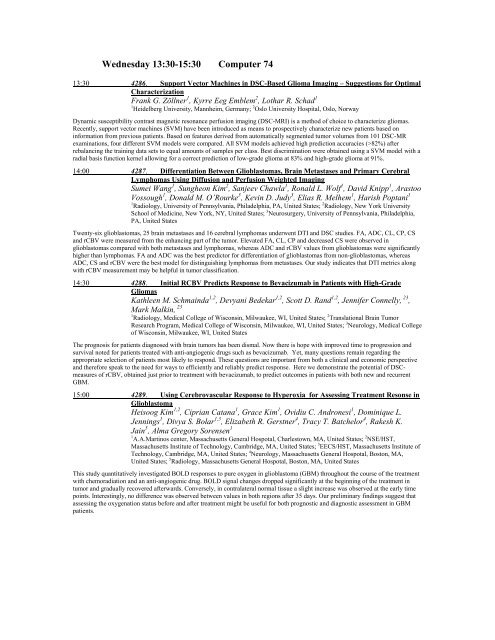Electronic Posters: Neuroimaging - ismrm
Electronic Posters: Neuroimaging - ismrm
Electronic Posters: Neuroimaging - ismrm
You also want an ePaper? Increase the reach of your titles
YUMPU automatically turns print PDFs into web optimized ePapers that Google loves.
Wednesday 13:30-15:30 Computer 74<br />
13:30 4286. Support Vector Machines in DSC-Based Glioma Imaging – Suggestions for Optimal<br />
Characterization<br />
Frank G. Zöllner 1 , Kyrre Eeg Emblem 2 , Lothar R. Schad 1<br />
1 Heidelberg University, Mannheim, Germany; 2 Oslo University Hospital, Oslo, Norway<br />
Dynamic susceptibility contrast magnetic resonance perfusion imaging (DSC-MRI) is a method of choice to characterize gliomas.<br />
Recently, support vector machines (SVM) have been introduced as means to prospectively characterize new patients based on<br />
information from previous patients. Based on features derived from automatically segmented tumor volumes from 101 DSC-MR<br />
examinations, four different SVM models were compared. All SVM models achieved high prediction accuracies (>82%) after<br />
rebalancing the training data sets to equal amounts of samples per class. Best discrimination were obtained using a SVM model with a<br />
radial basis function kernel allowing for a correct prediction of low-grade glioma at 83% and high-grade glioma at 91%.<br />
14:00 4287. Differentiation Between Glioblastomas, Brain Metastases and Primary Cerebral<br />
Lymphomas Using Diffusion and Perfusion Weighted Imaging<br />
Sumei Wang 1 , Sungheon Kim 2 , Sanjeev Chawla 1 , Ronald L. Wolf 1 , David Knipp 1 , Arastoo<br />
Vossough 1 , Donald M. O’Rourke 3 , Kevin D. Judy 3 , Elias R. Melhem 1 , Harish Poptani 1<br />
1 Radiology, University of Pennsylvania, Philadelphia, PA, United States; 2 Radiology, New York University<br />
School of Medicine, New York, NY, United States; 3 Neurosurgery, University of Pennsylvania, Philadelphia,<br />
PA, United States<br />
Twenty-six glioblastomas, 25 brain metastases and 16 cerebral lymphomas underwent DTI and DSC studies. FA, ADC, CL, CP, CS<br />
and rCBV were measured from the enhancing part of the tumor. Elevated FA, CL, CP and decreased CS were observed in<br />
glioblastomas compared with both metastases and lymphomas, whereas ADC and rCBV values from glioblastomas were significantly<br />
higher than lymphomas. FA and ADC was the best predictor for differentiation of glioblastomas from non-glioblastomas, whereas<br />
ADC, CS and rCBV were the best model for distinguishing lymphomas from metastases. Our study indicates that DTI metrics along<br />
with rCBV measurement may be helpful in tumor classification.<br />
14:30 4288. Initial RCBV Predicts Response to Bevacizumab in Patients with High-Grade<br />
Gliomas<br />
Kathleen M. Schmainda 1,2 , Devyani Bedekar 1,2 , Scott D. Rand 1,2 , Jennifer Connelly, 23 ,<br />
Mark Malkin, 23<br />
1 Radiology, Medical College of Wisconsin, Milwaukee, WI, United States; 2 Translational Brain Tumor<br />
Research Program, Medical College of Wisconsin, Milwaukee, WI, United States; 3 Neurology, Medical College<br />
of Wisconsin, Milwaukee, WI, United States<br />
The prognosis for patients diagnosed with brain tumors has been dismal. Now there is hope with improved time to progression and<br />
survival noted for patients treated with anti-angiogenic drugs such as bevacizumab. Yet, many questions remain regarding the<br />
appropriate selection of patients most likely to respond. These questions are important from both a clinical and economic perspective<br />
and therefore speak to the need for ways to efficiently and reliably predict response. Here we demonstrate the potential of DSCmeasures<br />
of rCBV, obtained just prior to treatment with bevacizumab, to predict outcomes in patients with both new and recurrent<br />
GBM.<br />
15:00 4289. Using Cerebrovascular Response to Hyperoxia for Assessing Treatment Resonse in<br />
Glioblastoma<br />
Heisoog Kim 1,2 , Ciprian Catana 1 , Grace Kim 1 , Ovidiu C. Andronesi 1 , Dominique L.<br />
Jennings 1 , Divya S. Bolar 1,3 , Elizabeth R. Gerstner 4 , Tracy T. Batchelor 4 , Rakesh K.<br />
Jain 5 , Alma Gregory Sorensen 1<br />
1 A.A.Martinos center, Massachusetts General Hospotal, Charlestown, MA, United States; 2 NSE/HST,<br />
Massachusetts Institute of Technology, Cambridge, MA, United States; 3 EECS/HST, Massachusetts Institute of<br />
Technology, Cambridge, MA, United States; 4 Neurology, Massachusetts General Hospotal, Boston, MA,<br />
United States; 5 Radiology, Massachusetts General Hospotal, Boston, MA, United States<br />
This study quantitatively investigated BOLD responses to pure oxygen in glioblastoma (GBM) throughout the course of the treatment<br />
with chemoradiation and an anti-angiogenic drug. BOLD signal changes dropped significantly at the beginning of the treatment in<br />
tumor and gradually recovered afterwards. Conversely, in contralateral normal tissue a slight increase was observed at the early time<br />
points. Interestingly, no difference was observed between values in both regions after 35 days. Our preliminary findings suggest that<br />
assessing the oxygenation status before and after treatment might be useful for both prognostic and diagnostic assessment in GBM<br />
patients.
















